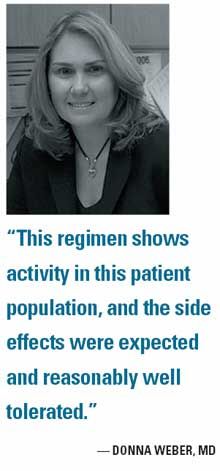Escalating doses of vorinostat amplify response in relapsed multiple myeloma
SAN FRANCISCO – Results from two early-phase clinical trials showed that adding vorinostat (Zolinza) to bortezomib can produce favorable response rates in up to 40% in patients with refractory or relapsed multiple myeloma. In the combined results of these two phase I trials, 39% of patients refractory or relapsed aft er bortezomib treatment achieved a partial response, and 43% had stable disease, said Donna Weber, MD, of M.D. Anderson Cancer Center in Houston.
SAN FRANCISCO – Results from two early-phase clinical trials showed that adding vorinostat (Zolinza) to bortezomib can produce favorable response rates in up to 40% in patients with refractory or relapsed multiple myeloma. In the combined results of these two phase I trials, 39% of patients refractory or relapsed aft er bortezomib treatment achieved a partial response, and 43% had stable disease, said Donna Weber, MD, of M.D. Anderson Cancer Center in Houston.

“This regimen shows activity in this patient population, and the side eff ects were expected-including gastrointestinal symptoms, fatigue, and thrombocytopenia-and relatively well tolerated,” Dr. Weber said.
The trials’ primary aims were to determine the maximum tolerated dose, and secondary aims were safety and effi cacy of this two-drug combination. In the first trial of 34 patients, patients received escalating doses of vorinostat (200 mg bid or 300 to 400 mg daily for 14 days). Bortezomib was given at doses of 0.7, 0.9, 1.1, or 1.3 mg/m,2 on days 4, 8, 11, and 15, and were repeated every 21 days for eight cycles or until progressive disease occurred. In the event of progressive disease, 20 mg of dexamethasone could be added on days 1 to 4 and 9 to 12. The highest dose of vorinostat was 400 mg daily, and the maximum tolerated dose was not determined because more than two doselimiting toxicities did not occur at any dose level (ASH 2008 abstract 871).
The 23 patients in the second trial received doses of vorinostat at 100 to 500 mg on days 4 to 11 and bortezomib at doses of 1 to 1.3 mg/m2 on days 1, 4, 8, and 11. Dexamethasone was added after cycle 2 for those patients who achieved less than a partial response and at cycle 4 for patients with progressive disease. The maximum tolerated dose of both drugs was determined to be 400 mg of vorinostat and 1.3 mg/m2 of bortezomib aft er two patients in the vorinostat 500 mg group experienced a dose limiting toxicity, one prolonged QT interval, and one grade 4 fatigue.
In the first trial, in which patients had received a median of four prior therapies, 38% achieved a partial response while 6% had progressive disease. In the second trial, in which patients had received a median of seven prior therapies, results indicated that 43% of patients achieved at least a partial response and 10% of patients had progressive disease. In those patients who had previously received bortezomib, the objective response rate was 35% in both trials, Dr. Weber said.
In the first study, grade 3 adverse events included thrombocytopenia (31%), fatigue (16%), neutropenia (10%), and neuropathy (3%). Overall gastrointestinal adverse events aff ected 50% to 60% of patients. In the second study, the major toxicities were hematologic, including anemia, neutropenia, and thrombocytopenia, but were managed in all patients. Grade 1 and 2 QT interval prolongation was noted in nine patients, but grade 3-4 prolongation was rare. No deaths occurred in either trial. While these results are encouraging, they are based on two small phase I trials and confi rmation in studies with larger patient numbers is necessary.
Two international multicenter trials are currently accruing based on these results, a phase II open label trial of vorinostat-bortezomib and the second a double-blind randomized phase III trial of bortezomib combined wiTheither placebo or vorinostat.
How Supportive Care Methods Can Improve Oncology Outcomes
Experts discussed supportive care and why it should be integrated into standard oncology care.